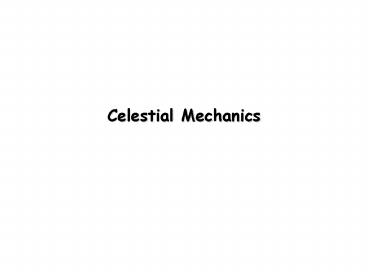Celestial Mechanics - PowerPoint PPT Presentation
1 / 18
Title:
Celestial Mechanics
Description:
Sometimes they show complex retrograde motions. Epicycles ... Retrograde motion. Retrograde motion is a natural outcome of the heliocentric model ... – PowerPoint PPT presentation
Number of Views:516
Avg rating:3.0/5.0
Title: Celestial Mechanics
1
Celestial Mechanics
2
Planetary motions
- The planets move relative to the background
stars. - Sometimes they show complex retrograde motions
3
Epicycles
- Epicycles were introduced to explain the
non-uniform velocities of planets, in a
geocentric, circular-orbit theory
4
Retrograde motion
- Retrograde motion is a natural outcome of the
heliocentric model - Inner planets orbit more quickly than outer
planets, and so overtake them
5
Distances to Interior planets
- Venus and Mercury follow the Sun around the
ecliptic means their orbits are smaller than
Earths - At greatest elongation a line between the Sun and
planet is perpendicular to a line between Earth
and planet.
- E.g. for Venus, q46 degrees, so the distance
from Venus to the Sun is 0.72 times the Earth-Sun
distance
6
Distances to exterior planets
- Exterior planets can be found anywhere in the
zodiacal belt - The true orbital period of the planet (sidereal
period) tells how long it takes the planet to
return to point P. - Observe the angles PES(initially) and PE?S (one
superior planet period later). - The angle ESE is known from the Earths orbital
period vs. the planets. And the triangles can be
solved.
7
Sidereal and synodic periods
It is easy to observe the synodic period this is
the time between successive oppostions (when the
Earth, Sun and planet are aligned).
- But how do we know when a planet has completed
one sidereal period (i.e. is in the same position
relative to the background stars?
The angular velocity of a circular orbit is
360/P. The synodic rate is the rate of the
planet relative to the Earth. So
8
Tycho Brahe
- Brahe (1546-1601) believed in a geocentric
Universe the Sun and moon go around the Earth
(but the other planets go around the Sun) - However, he also believed that this theory could
be tested by making sufficiently accurate
observations - At time this was a revolutionary approach
different from the idea that phenomena could be
understood through philosophical discourse alone - Arguably the first application of the scientific
method
9
Tycho Brahes observations
wall quadrant
- Made very accurate, naked eye observations of
planetary motion - Used devices for measuring angles and positions
- To measure time, he used the planetary motions
themselves. Clocks were rare and the pendulum
clock had not been invented
sextant
10
Keplers Laws
- Johannes Kepler derived the following 3 empirical
laws, based on Tycho Brahes careful observations
of planetary positions (astrometry). - A planet orbits the Sun in an ellipse, with the
Sun at one focus (supporting the Copernican
heliocentric model and disproving Brahes
hypothesis) - A line connecting a planet to the Sun sweeps out
equal areas in equal time intervals - P2a3, where P is the period and a is the average
distance from the Sun.
11
Break
12
What is an ellipse?
Definition An ellipse is a closed curve defined
by the locus of all points such that the sum of
the distances from the two foci is a constant
Ellipticity Relates the semi-major (a) and
semi-minor (b) axes
Equation of an ellipse
Substituting and rearranging we get
13
Ellipses
- Calculate the aphelion and perihelion distances
for Halleys comet, which has a semi-major axis
of 17.9 AU and an eccentricity of 0.967.
14
Keplers Second Law
- 2. A line connecting a planet to the Sun sweeps
out equal areas in equal time intervals - This is just a consequence of angular momentum
conservation.
15
Angular momentum conservation
- Since L is constant,
(aphelionperihilion)
16
Angular momentum conservation
- How much faster does Earth move at perihelion
compared with aphelion? The eccentricity is
e0.0167
i.e. 3.4 faster
17
Orbital angular momentum
- We know the angular momentum is constant but
what is its value?
Since L is constant, we can take A and t at any
time, or over any time interval.
18
Keplers Third Law
The general form of Keplers third law can be
derived from Newtons laws.
Example the dwarf planet Eris has a small moon,
Dysnomia. This moon orbits at a distance of
about 30,000 km, with a period of about 14 days.
What is the combined mass of the Eris/Dysnomia
system?






























